| Kilkerran Castle | |
|---|---|
 Top Of Kilkerran Castle | |
 | |
| General information | |
| Location | Argyll and Bute |
| Town or city | Campbeltown |
| Country | Scotland |
| Completed | 1490 |
Kilkerran Castle is a ruined castle, near Campbeltown, Kintyre, Argyll and Bute, Scotland. [1]
| Kilkerran Castle | |
|---|---|
 Top Of Kilkerran Castle | |
 | |
| General information | |
| Location | Argyll and Bute |
| Town or city | Campbeltown |
| Country | Scotland |
| Completed | 1490 |
Kilkerran Castle is a ruined castle, near Campbeltown, Kintyre, Argyll and Bute, Scotland. [1]
A keep was built in 1490 by King James IV, for the housing of a garrison to subdue the MacDonalds. [2]
Further fortification works were undertaken by King James V, [3] during an expedition to the Isles in 1536 against the Macdonalds and other turbulent clans.
As King James V sailed from Kilkerran (now Campbeltown), Alexander MacDonald, 5th of Dunnyveg took Kilkerran Castle by force and hung the governor from its walls in view of King James V. As a result, Alexander MacDonald was summoned to Stirling and died there in 1538.

Kintyre is a peninsula in western Scotland, in the southwest of Argyll and Bute. The peninsula stretches about 30 miles, from the Mull of Kintyre in the south to East and West Loch Tarbert in the north. The region immediately north of Kintyre is known as Knapdale.
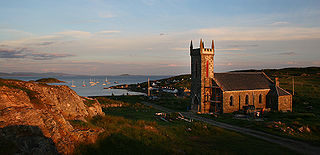
Coll is an island located west of the Isle of Mull in the Inner Hebrides of Scotland. Coll is known for its sandy beaches, which rise to form large sand dunes, for its corncrakes, and for Breacachadh Castle. It is in the council area of Argyll and Bute.

Clan Donald, also known as Clan MacDonald, is a Highland Scottish clan and one of the largest Scottish clans. The Lord Lyon King of Arms, who is the Scottish official with responsibility for regulating heraldry in that country, issuing new grants of coats of arms, and serving as the judge of the Court of the Lord Lyon, recognizes under Scottish law the High Chief of Clan Donald. Historically the chiefs of the Clan Donald held the title of Lord of the Isles until 1493 and two of those chiefs also held the title of Earl of Ross until 1476.

Campbeltown single malts are single malt Scotch whiskies distilled in the burgh of Campbeltown, on the Kintyre peninsula in Scotland. Once a major producer of whisky with as many as 30 distilleries, and claiming the title "whisky capital of the world", its production has markedly declined. Most of the distilleries have gone out of business and little trace of them remains. The reason for this decline was the fact that the town was "churning out whisky in volume ... with little concern for quality", according to a 2018 book that covers the entire industry and its history.
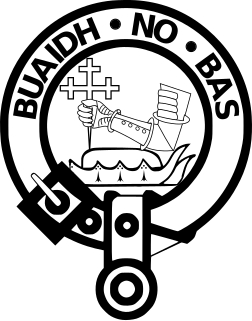
Clan MacDougall is a Highland Scottish clan, historically based in and around Argyll. The Lord Lyon King of Arms, the Scottish official with responsibility for regulating heraldry in Scotland, issuing new grants of coats of arms, and serving as the judge of the Court of the Lord Lyon, recognizes under Scottish law the Chief of Clan MacDougall. The MacDougall chiefs share a common ancestry with the chiefs of Clan Donald in descent from Somerled of the 12th century. In the 13th century the Clan MacDougall whose chiefs were the original Lords of Argyll and later Lords of Lorne was the most powerful clan in the Western Highlands. During the Wars of Scottish Independence the MacDougalls sided with the Clan Comyn whose chiefs rivaled Robert the Bruce for the Scottish Crown and this resulted in clan battles between the MacDougalls and Bruce. This marked the MacDougall's fall from power and led to the rise of their relatives, the Clan Donald, who had supported Bruce and also the rise to power of the Clan Campbell who were the habitual enemies of the MacDougalls and Clan Donald.
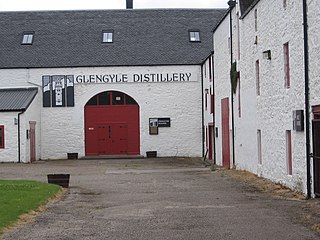
Glengyle distillery is a long-established Scotch whisky production centre in Campbeltown, Argyll & Bute, that closed down in 1925. In 2000 it was totally re-planned as the first new Scottish distillery of the millennium. Its single malts are bottled under the name Kilkerran.

Lochranza Castle is an L-plan fortified tower house situated on a promontory in Lochranza, on the northern part of the Isle of Arran in Scotland. Most of the castle was built in the 16th century.
Moidart is part of the remote and isolated area of Scotland, west of Fort William, known as the Rough Bounds. Moidart itself is almost surrounded by bodies of water. Loch Shiel cuts off the eastern boundary of the district and continues along part of the southern edge. The remainder of the southern edge is cut off by Loch Moidart. The north is cut off by Loch Morar and Loch Ailort.

Lorne is an ancient province in the west of Scotland, which is now a district in the Argyll and Bute council area. The district gives its name to the Lynn of Lorn National Scenic Area, one of forty such areas in Scotland, which have been defined so as to identify areas of exceptional scenery and to ensure its protection from inappropriate development. The national scenic areas cover 15,726 ha, of which 10,088 ha are marine seascape, and includes the whole of the island of Lismore, along with neighbouring areas on the mainland such as Benderloch and Port Appin, and the Shuna Island.

Clan MacDonald of Keppoch, also known as Clan Ranald of Lochaber, is a Scottish clan and a branch of Clan Donald. The Clan MacDonald of Keppoch has a chief that is recognized by the Lord Lyon King of Arms and the Court of the Lord Lyon.
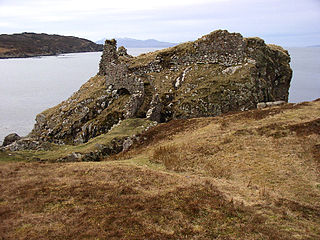
Dunscaith Castle also known as Dun Scaich, Dun Sgathaich Castle and Tokavaig, is a ruined castle on the coast of the Isle of Skye, in the north-west of Scotland. It is located in the Parish of Sleat, in the Highland council area, and in the former county of Inverness-shire, at grid reference NG595120. Also called "Fortress of Shadows", it is named after and was the home of the warrior maiden Scáthach. It is protected as a scheduled monument.
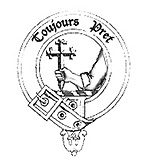
Clan MacDonald of Dunnyveg, also known as Clan Donald South, Clan Iain Mor, Clan MacDonald of Islay and Kintyre, MacDonalds of the Glens (Antrim) and sometimes referred to as MacDonnells, is a Scottish clan and a branch of Clan Donald. The founder of the MacDonalds of Dunnyveg is Eòin Mòr Tànaiste Mac Dhòmhnaill, a son of Iain Mic Dhòmhnaill and Margaret Stewart of Scotland, daughter of King Robert II. Members of the clan actually pronounced and spelled their name M'Connall due to the Gaelic pronunciation of the name Mac Domhnuill thus giving rise to the surname McConnell and its variants. While historically recognised as a clan by the Court of the Lord Lyon, it is now an armigerous clan as it no longer has a chief. The last chief was Sir James MacDonald, 9th of the Clan MacDonald of Dunnyveg or Clan Donald South, who died in London in 1626.

Saddell Abbey is a ruined Cistercian monastery located in western Scotland. The abbey was established in 1160 by Somerled, Lord of Kintyre, who was killed in 1164. The abbey was completed by his son, Ragnall, a few years later. The original layout of the abbey included a church and three adjoining buildings grouped around a cloister. Saddell Abbey is widely known for its important collection of life-sized stone carvings and burial slabs that were constructed from the 14th to the 16th centuries. Historic Environment Scotland established the site as a scheduled monument in 1975.
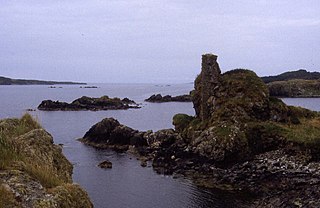
Dunyvaig Castle, is located on the south side of Islay, in Argyll, Scotland, on the shore of Lagavulin Bay, 4 kilometres from Port Ellen. The castle was once a naval base of the Lord of the Isles, chiefs of Clan Donald. It was held by the chiefs of the Clan MacDonald of Dunnyveg.

Finlaggan is a historic site on Eilean Mòr in Loch Finlaggan. The Loch, the island, and Finlaggan Castle lie on Islay, around two kilometres to the northwest of Ballygrant.

The Battle of the Western Isles was a series of conflicts in 1585 and 1586 on the islands of Jura, Islay, Mull and Tiree, Scotland as well as the peninsula of Kintyre on the mainland. However, although the historic sources describe this as having taken place in the "Western Isles" which are now known as the Outer Hebrides, all of the aforementioned locations are actually in the Inner Hebrides. It was fought between the Clan Macdonald of Sleat and Clan MacDonald of Dunnyveg against the Clan Maclean. In 1585, the Macleans slaughtered a party of the MacDonalds of Sleat when they were mistakenly accused of stealing cattle and the MacDonalds of Sleat and Dunnyveg retaliated. James VI of Scotland intervened but the conflicts continued into 1586. After further intervention an Act of Parliament was passed which would levy fines on any clan chiefs who did not maintain peace and good order among their vassals.

Tarbert Castle is located on the southern shore of East Loch Tarbert, at Tarbert, Argyll, Scotland, at the north end of Kintyre. Tarbert Castle was a strategic royal stronghold during the Middle Ages and one of three castles at Tarbert. The castle overlooks the harbour and although pre 14th century in construction, the tower dates back to 1494 and the visit of James IV to the Western Highlands.

Airds Castle is a ruined medieval castle near Carradale, Kintyre, Argyll and Bute, Scotland. The castle held a position on the summit of a rocky headland between Carradale harbour and the bay of Port Righ, looking across Kilbrannan Sound to the Isle of Arran.

Saddell Castle is a historic 16th-century castle on the shore of the Kilbrannan Sound near Saddell, Kintyre, Argyll and Bute, Scotland of significant importance. The original castle existed in Somerled's time in the 12th century. The castle served as a bastion of the MacDonald family for several centuries and continues to be visited by MacDonald diaspora from around the world who return to Western Scotland and the Isles. Several MacDonald Lords have resided at Saddell over the centuries, including Alasdair Mor MacDonald, younger brother of Angus Mor MacDonald, Lord of the Isles in the 13th century. Angus Og MacDonald once provided refuge to Robert the Bruce during the First War of Scottish Independence in the early 14th century before taking him on to Dunaverty Castle on the Mull of Kintyre.
The siege of Inverness of 1429 was a conflict between Alexander of Islay, Earl of Ross and the Scottish crown. Alexander of Islay besieged the royal Inverness Castle and burnt the town of Inverness to ashes.
Coordinates: 55°25′1″N5°35′23″W / 55.41694°N 5.58972°W